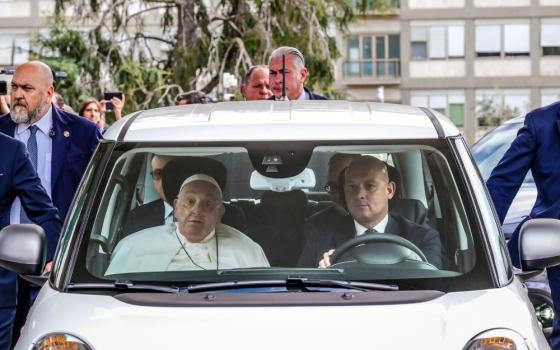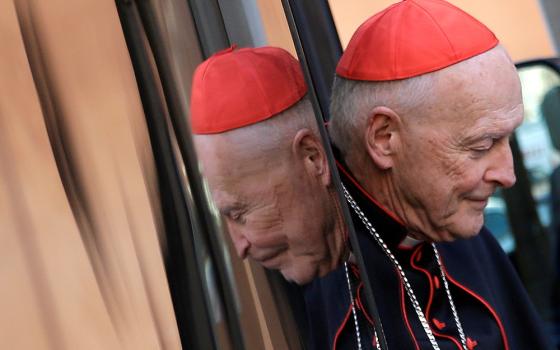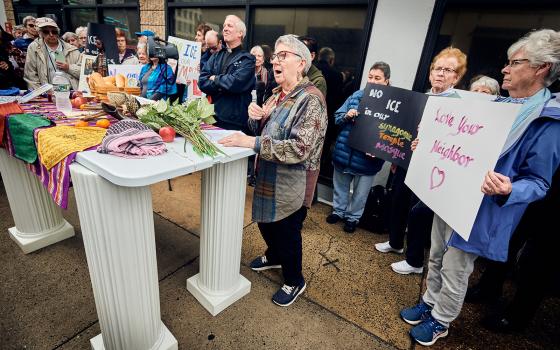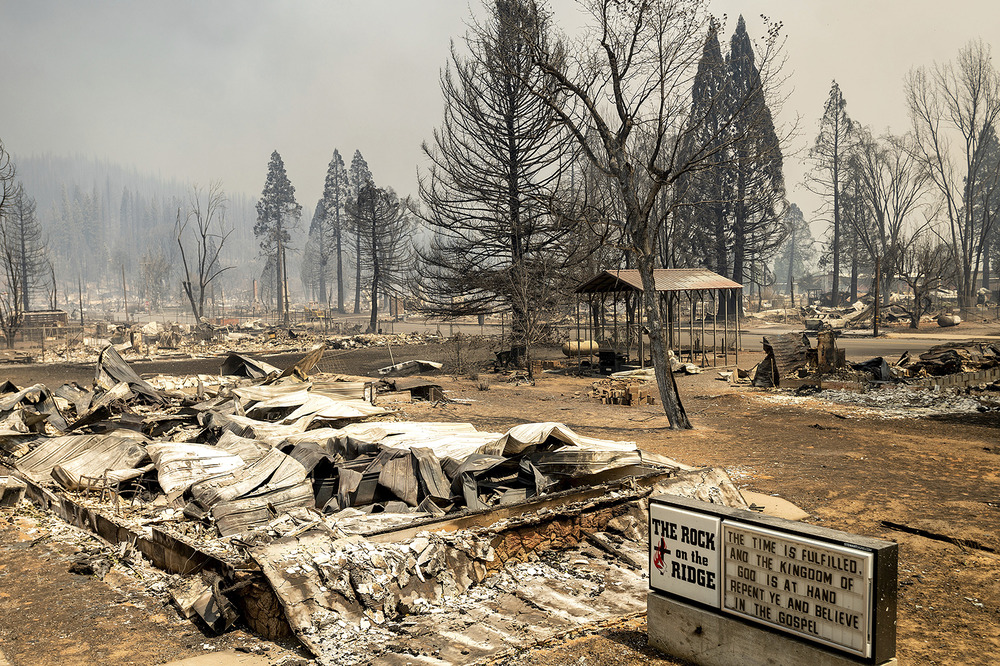
A church marquee stands among buildings destroyed by the Dixie Fire in Greenville on Aug. 5, 2021, in Plumas County, Calif. (AP/Noah Berger)
The Rev. John Parks was taking his first sabbatical in 40 years of ministry when he got a call from his church’s accountant with some bad news.
Church Mutual, the church’s insurance company, had dropped them.
"This does not make sense," Parks, the pastor of Ashford Community Church in Houston, recalls thinking at the time. "We’ve never filed a claim."
Five months and 13 insurance companies later, the church finally found replacement coverage for $80,000 per year, up from the $23,000 they had been paying.
"It’s been an adventure," said the 69-year-old Parks from his home in Houston, where the power was out after Hurricane Beryl. "That’s putting it politely."
Parks and his congregation are not alone. An ongoing wave of disasters — Gulf Coast hurricanes, wildfires in California, severe thunderstorms and flooding in the Midwest — along with skyrocketing construction costs post-COVID have left the insurance industry reeling.
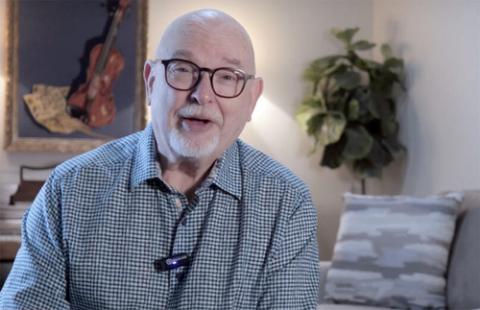
The Rev. John Parks in a video for Ashford Community Church. (Video screen grab)
As a result, companies such as Church Mutual, GuideOne and Brotherhood Mutual, which specialize in insuring churches, have seen their reserves shrink. That’s led them to drop churches they consider high risk in order to cut their losses.
Hundreds of United Methodist churches in the Rio Texas Annual Conference learned they’d lost property insurance in November last year, leaving church officials scrambling. More than six months later, some churches have found new insurance, often at a steep increase. Others still have none, said Kevin Reed, president of the conference board of trustees.
Reed said the conference had about a month’s notice that its property insurance policy, which local congregations could buy into, was being canceled. That wasn’t enough time to find new coverage before the policy expired. It also left local churches on their own.
"We have not found a good solution," said Reed. "It continues to be a significant problem for our churches."
United Methodist churches in Iowa have also lost insurance, according to the Iowa Annual Conference, in the aftermath of severe weather in the area. The Rev. Ron Carlson, treasurer of the Iowa conference, said that both small rural churches and larger churches have been affected. Carlson said the conference reminded churches earlier this year to be proactive in checking on their insurance and not waiting for a renewal offer.
The UMC’s Book of Discipline requires churches to carry insurance for the full replacement cost of their buildings as well as liability insurance. For some churches, said Carlson, that’s just not possible. He said the conference is trying to sort out what happens to those churches.
For struggling churches dealing with declining membership and giving, he said, rising insurance may be the last straw.
"There have been some that have said we can’t do this anymore," he said.
For churches that lost their insurance, finding replacement coverage is difficult. That’s in part because churches are a niche market that’s difficult to insure and full of risk, say experts. They are open to the public, work with everyone from infants to senior citizens, sometimes house social service programs, are run by volunteers and often have large and expensive buildings.
Churches also operate with little oversight, said Charles Cutler, president of ChurchWest Insurance Services, which works with about 4,000 churches and other Christian ministries.
"Because of the First Amendment and the separation of church and state, ministries are largely unregulated," said Cutler. "And unregulated businesses are difficult to underwrite."
The church insurance market, like the insurance industry overall, has been hit with a perfect storm in recent years. Supply chain shortages for construction materials that began during the pandemic have driven up the cost of rebuilding after a disaster. When the cost of rebuilding goes up, so does the size of claims, said Cutler. That led insurance companies to raise their rates in order to cover those claims.
Then a series of natural disasters hit the industry hard — including hurricanes, wildfires and what are known as "severe convective storms" — thunderstorms with extreme rain and wind that caused billions in damage last year, according to the Insurance Journal. Claims from those disasters have stressed the reserves that insurance companies use to pay claims.
AM Best, a credit rating agency that specializes in the insurance industry, cited weather and cost from legal claims as reasons for placing Church Mutual under review this past spring. AM Best also downgraded the rating of Brotherhood Mutual, another major church insurer, while a third church insurer, GuideOne, was taken off review after Bain Capital invested $200 million in the company.
In a statement on its website, Church Mutual said it hopes the company’s outlook will improve.
"Church Mutual has been proactively addressing these challenges to better manage the risks throughout its book of business, nationwide," the company said. "The company’s leadership team is confident these measures will have a significant, positive impact on profitability in 2024 and beyond."
Pam Rushing, the chief underwriting officer for Church Mutual, said that the company is still renewing policies and accepting new business in every state. However, the company no longer offers property coverage in Louisiana. Church Mutual did not give details of how many policies have been canceled.
"We do not take nonrenewal decisions lightly and it represents a small percentage of our overall portfolio," Rushing said in an email. "For us to remain financially strong, viable and best able to serve our mission, we need to mitigate the severe impact catastrophic weather has had – and will continue to have – on our bottom line and our ability to serve customers nationwide."
Brad Hedberg, executive vice president of The Rockwood Co., a Chicago-based agency, said church insurers are facing pressure from the reinsurers — large companies such as Lloyd’s of London that provide insurance to insurance companies so catastrophic claims don’t overwhelm them. Those companies are looking to reduce their exposure to certain types of claims— meaning church insurers can’t offer as much coverage as they did in the past.
Advertisement
Hedberg, who works with churches and other ministries, said he spends a lot of time helping clients keep the insurance they already have and reduce their risk of filing claims. That means making sure churches have policies in place for everything from abuse prevention to who gets to drive the church van, as well as being proactive with building maintenance and safety projects. It also means being strategic in when to file a claim — and when to pay for a loss out of pocket. Churches should only tap their insurance for large losses — not small claims, he added.
"If small claims get filed, your coverage could be nonrenewed or your premium could go through the roof," he said. "The market is just that bad."
Once a church loses coverage, it may face higher prices for years. That’s likely the case for Bethany Covenant Church in Berlin, Connecticut, said Greg Pihl, who chairs the church’s finance committee.
The church had been paying $12,500 for insurance and had made a claim for flooding damage due to a faulty sprinkler. Pihl said the church learned this past spring that its insurance had been canceled. Now Bethany will pay about $73,000 for less coverage, said Pihl.
That made for a difficult conversation at a church business meeting and midyear changes to the church’s budget. The church was able to tap some reserves to cover the increased premium this year. But it’ll likely be paying higher rates for the next three to five years, said Pihl. And those reserves, meant to pay for things like a new roof, still have to be built back up.
Pihl said that before the church’s policy was canceled, he expected rates to go up, perhaps by 10% or 20%. But that proved overly optimistic.
"It’s just a terrible market," he said.
Nathan Creitz, pastor of Calvary Baptist Church in Bay Shore, New York, a congregation of about 100 people on Long Island, said that in the past, getting insurance hadn’t been a worry. The total annual cost for all the church’s insurance — the church building, a parsonage, liability — was less than $4,000.
"We got lucky," he said. "We were grandfathered into some really low rates."
Things changed last summer after Calvary’s insurance carrier dropped the church, deciding not to renew the policy. With the help of a broker, the church found new insurance for about $14,000. Since most of the costs of running a church, such as paying staff and keeping the lights on, are already fixed, that meant cutting programs. The church also had to put off capital improvements to the building, which ironically are the kinds of things that would make them easier to insure.
"It’s not ideal but that’s what happened," Creitz said.
For Ashford Community Church in Houston, finding the funds to cover the increased insurance has also been a challenge, especially post-COVID, when church attendance and giving are down.
Higher insurance costs also mean less money for ministry at the church, which Parks described as a mission-focused congregation.
The church’s 40,000-square-foot facility is currently home to about a dozen congregations, through a partnership called Kingdom City Houston. Parks said he came to the church about a decade ago after hopes of starting a church overseas fell apart. At the time, the church was struggling and was using only a quarter of the space in its building.
Today about 1,200 people worship every weekend in the building — which holds multiple services in its three sanctuaries. Parks said worshippers come from more than 60 countries. The churches each have their pastors but share some back-office staff.
The idea is to show that Christians from different backgrounds can still be united. "We can walk side by side, even if we don’t always see eye to eye," he said.
Parks said Ashford’s building has been largely untouched by recent storms. After Hurricane Harvey caused massive flooding in 2017, the church hosted volunteers from around the country who helped residents recover.
"It was a good time of serving the community," he said.
